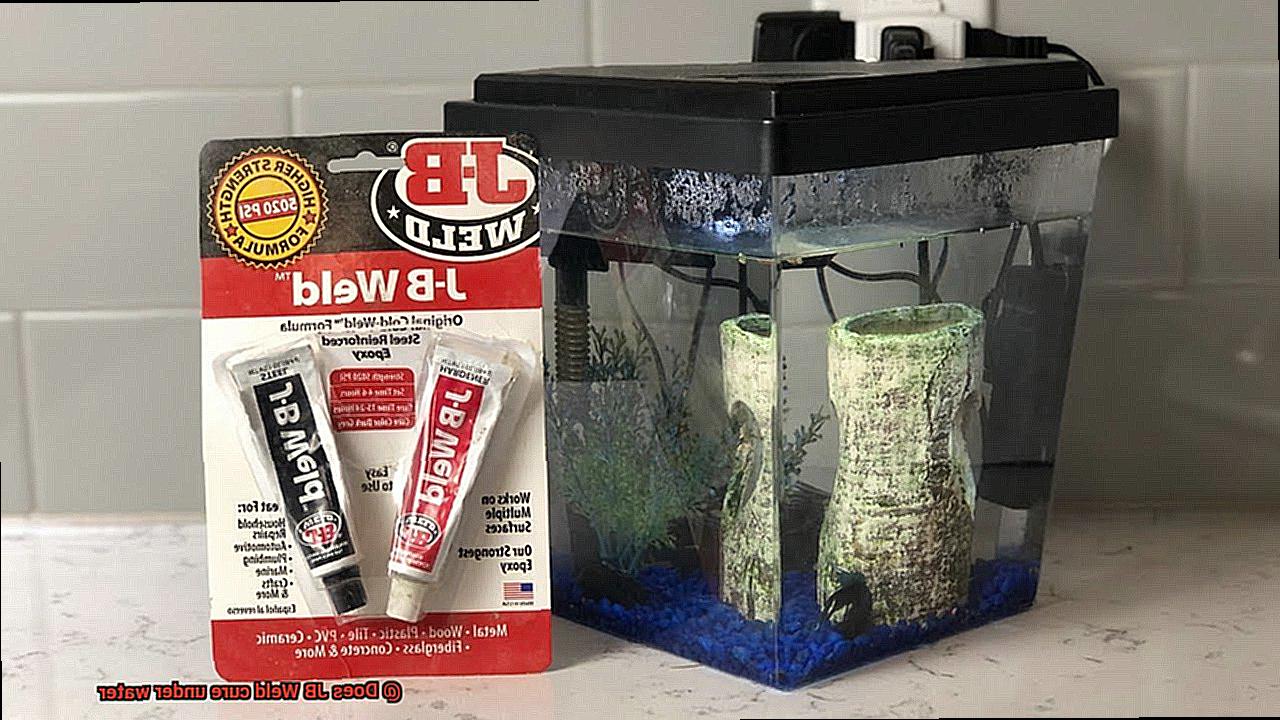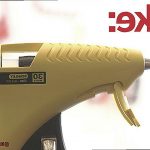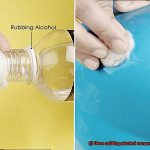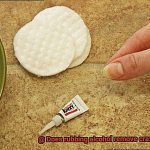Imagine this: you find yourself waist-deep in a murky pond, water swirling around your boots, desperately seeking a solution for that pesky leak in your boat hull. Or perhaps you’re an avid swimmer, facing the daunting task of fixing a crack in your pool’s underwater ladder. In both scenarios, one burning question remains: Can JB Weld, the legendary epoxy adhesive, work its magic underwater?
Today, we embark on a thrilling deep-sea expedition to uncover the hidden potential of JB Weld when submerged. With decades of research and groundbreaking innovation under its belt, JB Weld has earned its stripes as a trusted adhesive powerhouse known for unmatched strength and durability. But does it truly live up to the hype beneath the waves? Join us as we plunge into the depths to explore the effectiveness, benefits, and real-world applications of using JB Weld in underwater environments.
Whether you’re a DIY veteran or a seasoned professional, the knowledge we unearth here will equip you with everything you need to tackle ambitious projects below the surface. From boat repairs to pool fixes and beyond, discover how JB Weld can be your ultimate ally when navigating treacherous waters. So strap on your scuba gear and let’s dive headfirst into the extraordinary possibilities offered by JB Weld in conquering the challenges of underwater repairs.
What is JB Weld?
Contents
- 1 What is JB Weld?
- 2 How Does JB Weld Work?
- 3 Can JB Weld Cure Underwater?
- 4 Factors Affecting Curing Process of JB Weld Underwater
- 5 Advantages of Using JB Weld Underwater
- 5.1 Versatility – The Underwater Chameleon:
- 5.2 Unbreakable Bonds – Withstand the Depths:
- 5.3 Time is Money – Swift Repairs Below:
- 5.4 Budget-Friendly – Dive into Savings:
- 5.5 Longevity – Enduring the Depths of Time:
- 5.6 Seamless Application – Dive into Simplicity:
- 5.7 Temperature Tolerance – Adhesive for All Conditions:
- 6 Disadvantages of Using JB Weld Underwater
- 7 Proper Surface Preparation for Bonding with JB Weld Underwater
- 8 Alternatives to Using JB Weld Underwater
- 9 Conclusion
When it comes to adhesive solutions, there is one name that stands head and shoulders above the rest: JB Weld. Whether you’re a seasoned DIY enthusiast, a professional in need of an unbreakable bond, or a hobbyist looking to conquer diverse projects, JB Weld is the adhesive superhero you need in your toolbox. In this article, we will venture into the remarkable world of JB Weld and discover why it has become an indispensable staple for countless individuals.
Strength and Durability:
Prepare to be amazed by the unparalleled strength and durability of JB Weld. This two-part epoxy adhesive forms a bond so robust that it scoffs at high temperatures, chemicals, and even the harshest environmental conditions. It fearlessly conquers various materials with its permanent fix, including metal, wood, plastic, ceramic, and more.
Versatility:
JB Weld’s versatility knows no bounds, making it an invaluable companion for infinite applications. From automotive repairs to plumbing marvels and household feats, JB Weld has got your back. But wait, there’s more. This adhesive powerhouse can even cure underwater, setting it apart from the competition and making it the ultimate choice for marine repairs or any project involving water exposure.
Easy to Use:
JB Weld’s user-friendly nature adds to its allure. With its syringe-like packaging, dispensing and mixing the resin and hardener components in the perfect ratio is a breeze. And don’t worry about racing against the clock – JB Weld gives you ample working time before it starts to cure, allowing you to apply it with precision and confidence.
Research Notes:
While JB Weld boasts remarkable underwater curing abilities due to its unique formulation and water-resistant additives, please note that its performance underwater may still be affected by the presence of water. For optimal results in underwater applications, consider using adhesives specifically designed for this purpose.
How Does JB Weld Work?
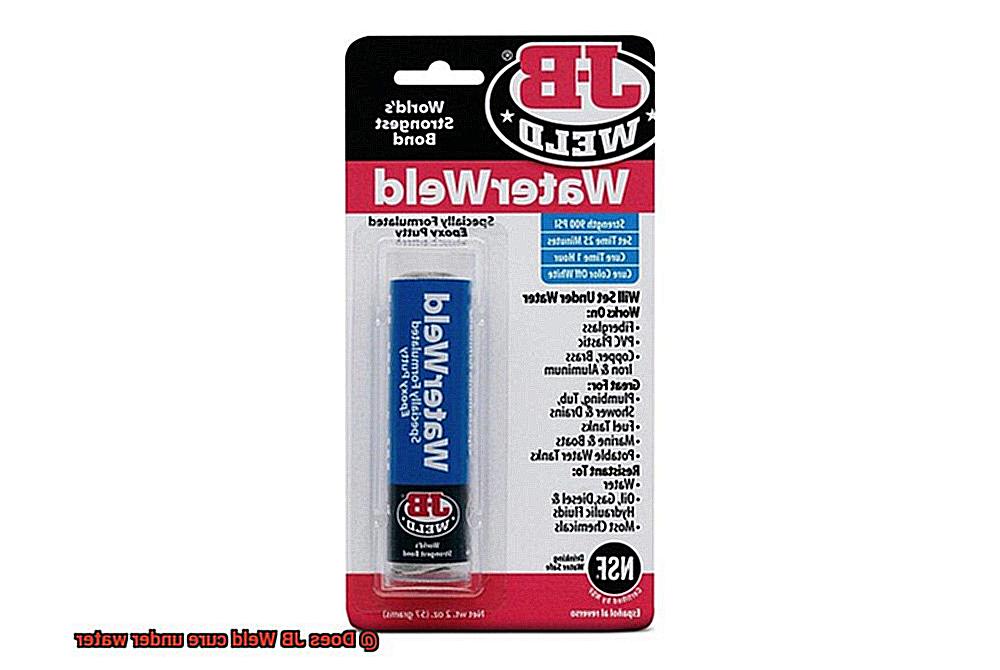
Whether you’re a seasoned DIY enthusiast or simply curious about the wonders of glue, this article will delve into the secrets behind how JB Weld works and why it’s a game-changer in the world of adhesives.
The Dynamic Duo: Resin and Hardener:
JB Weld is a two-part epoxy adhesive, composed of resin and hardener. These two components must be mixed together in equal parts to initiate a chemical reaction called curing. Think of it as a partnership between two powerful elements, coming together to create something extraordinary.
The Magic of Curing:
Curing is where the real magic happens. When the resin and hardener come into contact, they begin to react and bond together. This reaction is exothermic, meaning it releases heat as it cures.
The generated heat accelerates the curing process, resulting in a bond that is as strong as steel.
Versatile Bonding Power:
One of the reasons JB Weld is loved by DIYers everywhere is its ability to bond to an impressive range of surfaces. Metals like steel, iron, aluminum, brass, and copper are no match for JB Weld’s tenacity. It also forms strong bonds with ceramics, concrete, glass, fiberglass, plastics, and even wood. With JB Weld in your toolkit, you’ll be ready for any repair or project that comes your way.
Molecular Marvels:
The secret behind JB Weld’s incredible strength lies in its ability to form cross-linked polymer chains during curing. These chains intertwine with the molecules of the surfaces being bonded, creating an unbreakable connection. It’s like a molecular dance where JB Weld takes hold and refuses to let go.
Defying the Elements:
JB Weld doesn’t back down from a challenge. Once fully cured, it becomes resistant to water, chemicals, petroleum, gasoline, and extreme temperatures. It’s like a force field that shields your repairs from the harshest of conditions. Rain or shine, JB Weld stands strong.
Preparation is Key:
To ensure the best results with JB Weld, proper surface preparation is crucial. Before applying the adhesive, make sure the surface is clean and free from dirt, grease, or oil that could interfere with bonding. A light roughening of the surface can also enhance adhesion, ensuring a bond that lasts a lifetime.
Can JB Weld Cure Underwater?
Today, we embark on a journey into the depths to uncover the truth about JB Weld’s ability to cure underwater. Brace yourselves for a captivating adventure filled with chemistry, innovation, and the quest for answers.
The Chemistry Behind JB Weld:
To understand how JB Weld interacts with water, let’s delve into its chemistry. JB Weld consists of two main components: a resin and a hardener. When these components unite, a mesmerizing chemical reaction occurs, generating heat that propels the curing process forward.
The Mysterious Underwater World:
Now, let’s venture into the enigmatic realm where aquatic conundrums await. While JB Weld is not specifically designed for underwater curing, resourceful users have reported success in this domain. However, it’s crucial to acknowledge that water can potentially impede or halt the curing process.
Overcoming the Challenges:
Crafty users have devised techniques to overcome these challenges. Here are some approaches that have shown promise:
- Preheating the Mixture: By raising the temperature of the JB Weld mixture before applying it underwater, users aim to counteract the cooling effect of water. This helps maintain an environment conducive to curing.
- Ensuring Optimal Depths and Pressures: The depth at which JB Weld is applied can influence its effectiveness. Higher pressures may create a more challenging environment for the epoxy to set properly.
While stories of successful underwater cures exist, caution must be exercised when using JB Weld in such conditions. The product’s manufacturer does not endorse or guarantee its efficacy underwater. Environmental factors such as water temperature, pressure fluctuations, and specific project requirements significantly impact the outcome.
So, can JB Weld cure underwater? The answer lies in the realm of possibilities. While not explicitly designed for underwater applications, resourceful users have achieved success by employing innovative techniques. However, it’s crucial to approach underwater projects with care, adhering to manufacturer guidelines and conducting thorough testing. Safety and effectiveness should be our guiding lights in these uncharted waters.
Factors Affecting Curing Process of JB Weld Underwater
The factors that affect the curing process of JB Weld underwater are temperature, water flow, water depth, surface preparation, application technique, and water quality.
Temperature plays a crucial role in the curing process of JB Weld underwater. Cold temperatures slow down the curing process, while warmer temperatures can speed it up. However, extreme temperatures, both hot and cold, can compromise the strength of the cured JB Weld. Finding the optimal temperature is essential for achieving successful results.
Water flow is another factor to consider when using JB Weld underwater. Strong water currents or rivers can hinder the curing process by constantly moving the water and preventing proper adhesion and bonding. To overcome this challenge, creating a barrier or redirecting the water flow can provide a better environment for curing.
Water depth also affects the curing time and strength of the bond. As you descend into deeper waters, the pressure increases, which can lengthen the curing time of JB Weld. It is important to be aware of this and adjust expectations accordingly when working deep underwater.
Proper surface preparation is crucial for a successful bond underwater. The surface should be clean, dry, and free from any debris or contaminants that could compromise adhesion. Roughening the surface with sandpaper or a wire brush can provide more surface area for JB Weld to grab onto and improve bonding.
When applying JB Weld underwater, technique matters. Applying a thin layer evenly onto the prepared surface and pressing the two surfaces together firmly is recommended. Removing any excess JB Weld is important as it can interfere with the curing process.
Water quality can impact the curing process as well. Chemicals or contaminants in the water may interfere with the curing agents in JB Weld, leading to slower or incomplete curing. Using clean, fresh water whenever possible is advisable to minimize any potential issues related to water quality.
Advantages of Using JB Weld Underwater
With JB Weld, that world becomes a reality. This versatile epoxy adhesive opens up a whole new realm of possibilities for fixing leaks, cracks, and broken parts beneath the surface. In this blog post, we will explore the advantages of using JB Weld underwater and how it can revolutionize your underwater repair projects.
Versatility – The Underwater Chameleon:
JB Weld is the ultimate chameleon of adhesives, capable of bonding various materials together underwater. From metal and wood to plastic and ceramic, JB Weld can handle it all. Whether you’re patching up a leak in a pipe or fixing an equipment malfunction, this adhesive is your go-to solution.
Unbreakable Bonds – Withstand the Depths:
When it comes to underwater repairs, durability is key. JB Weld creates incredibly strong and durable bonds that resist water, chemicals, and extreme temperatures. It’s like having a superpower for your repairs. Say goodbye to worrying about your fix failing under the pressure of water or harsh underwater conditions.
Time is Money – Swift Repairs Below:
Underwater repairs can be time-consuming and challenging, but not with JB Weld. Unlike traditional adhesives that require lengthy drying times, JB Weld cures quickly even underwater. This means less downtime and more time enjoying your underwater adventures or getting back to work.
Budget-Friendly – Dive into Savings:
Hiring specialized professionals or purchasing expensive equipment for underwater repairs can put a dent in your wallet. Luckily, JB Weld provides a cost-effective alternative. You can achieve reliable results without breaking the bank.
Longevity – Enduring the Depths of Time:
Nobody wants their repair job to fail shortly after completion. With JB Weld, you can rest easy knowing that your fixes will stand the test of time. Its strong bond ensures that your repaired objects remain intact, even in the harshest underwater conditions.
Seamless Application – Dive into Simplicity:
Applying JB Weld underwater is a breeze. Its user-friendly two-part system is easy to mix and apply directly onto the surface that needs repair. The thick consistency allows it to stay in place underwater, ensuring a proper bond that will hold up against the currents.
Temperature Tolerance – Adhesive for All Conditions:
Underwater conditions can vary in temperature, but that doesn’t faze JB Weld. Engineered to work effectively in a wide range of temperatures, this adhesive is suitable for both cold and warm water environments. No matter where your underwater project takes you, JB Weld has got you covered.
Disadvantages of Using JB Weld Underwater
When it comes to underwater repairs, many individuals consider JB Weld as a potential solution due to its versatility and durability. However, it is crucial to understand the limitations and potential disadvantages associated with using JB Weld in such conditions. This article aims to shed light on these drawbacks, providing insight into the challenges faced when using JB Weld underwater.
Bonding and Curing Challenges:
One of the primary disadvantages of using JB Weld underwater is that water interferes with its bonding and curing process. JB Weld relies on a chemical reaction between its two components to harden, but the presence of water can hinder this reaction. As a result, proper bonding and curing may not occur, compromising the strength and longevity of the repair.
Surface Preparation Difficulties:
Achieving a strong bond requires thorough surface preparation, including cleaning and drying the surfaces before applying the adhesive. However, underwater conditions make it incredibly challenging to ensure the surfaces are adequately prepared. Turbulence, currents, and other factors in submerged environments can further complicate the application and maintenance of the adhesive.
Risk of Displacement:
Water movement poses a significant risk when using JB Weld underwater. The adhesive may be washed away or displaced by the constant flow of water, compromising the integrity of the bond. Even if the initial bond holds, continuous exposure to water weakens it over time, leading to deterioration and potential failure.
Voiding Warranties or Guarantees:
Using JB Weld in unintended ways, such as underwater applications, can void any warranties or guarantees provided by the manufacturer. Manufacturers design their products for specific conditions, and using them outside of their intended purpose can lead to unforeseen consequences.
Proper Surface Preparation for Bonding with JB Weld Underwater
Imagine the challenge of needing a reliable adhesive for an underwater repair, and behold the superhero of adhesives – JB Weld. But before you take the plunge, it’s crucial to follow the necessary steps for successful bonding.
In this guide, we’ll explore the proper surface preparation techniques for bonding with JB Weld underwater. So gear up in your wetsuit, and let’s dive into the world of watertight bonding.
Step 1: Cleanliness is the Foundation:
Underwater surfaces are often plagued with contaminants that can compromise the adhesive properties of JB Weld. Start by using a mild detergent or soap and water solution to remove visible dirt and debris. Thoroughly rinse to ensure no soapy residue remains, as it can hinder the bonding process.
Step 2: Roughen for Resilience:
To enhance adhesion, lightly sand the surfaces to be bonded using fine-grit sandpaper. Employ a circular motion to create a slightly roughened texture without removing excessive material. This textured surface will provide JB Weld with a secure grip.
Step 3: Banish Impurities:
After sanding, wipe down the surfaces with a solvent like acetone or rubbing alcohol. These solvents eliminate any lingering contaminants and guarantee a clean surface for optimal adhesion. Utilize a clean cloth or paper towel soaked in the solvent and wipe meticulously.
Step 4: Dryness is Paramount:
Before applying JB Weld, ensure that the surfaces are completely dry. Any moisture present can interfere with the epoxy’s curing process. Use a dry cloth or allow natural air drying before proceeding.
Step 5: Layer by Layer:
For maximum bonding strength underwater, apply JB Weld in multiple thin layers rather than one thick layer. This approach allows each layer to cure properly and ensures superior adhesion between the surfaces. Utilize a disposable brush or spatula to spread the epoxy evenly over the entire bonding area.
Step 6: Patience Rewarded:
Once JB Weld is applied, exercise patience and allow ample time for curing before exposing it to water. Curing time may vary depending on the product and environmental conditions, so strictly adhere to the manufacturer’s instructions. Avoid contact with water during the curing process to achieve an exceptional bond.
Alternatives to Using JB Weld Underwater
When it comes to underwater repairs, JB Weld is a popular choice for its reliability and strength. However, there are situations where using JB Weld may not be the best option. In this article, we will explore alternative solutions for bonding materials underwater, giving you a range of choices for your underwater repair needs.
Epoxy Putty:
Epoxy putty is a versatile adhesive that can bond a wide range of materials, including metal, plastic, and wood. It can cure underwater, making it ideal for underwater repairs. Simply mix the two parts of epoxy putty together, mold it to fit the repair area, and let it cure.
Marine-Grade Adhesive Sealants:
Specifically designed for marine environments, these sealants are capable of bonding materials together even when submerged in water. They offer excellent resistance to water, UV rays, and other harsh conditions found in marine settings. Use them for sealing leaks in boat hulls or bonding underwater fixtures.
Silicone Adhesives:
Silicone adhesives are known for their flexibility and resistance to water and extreme temperatures. They form strong bonds between different materials and are commonly used in plumbing, automotive, and construction industries. Apply them using a caulking gun for easy application.
Two-Part Epoxy Adhesives:
Certain types of two-part epoxy adhesives can cure underwater and provide reliable bonding. These adhesives are designed to withstand exposure to moisture and create strong bonds between various materials. Ensure that the specific epoxy adhesive chosen is suitable for underwater applications.
Mechanical Fasteners:
In some cases, mechanical fasteners such as bolts or screws may be a practical alternative to using adhesives underwater. They provide a secure and reliable connection between materials even when submerged. This option is more suitable for situations where adhesive use is not feasible or desirable.
Also Read: Will JB Weld Work On PVC Pipes? – The Welding Guru
Conclusion
In conclusion, the answer to the question “Does JB Weld cure under water?”
is a resounding yes. This remarkable adhesive has the ability to bond and cure even in the most challenging underwater environments.
Whether you’re fixing a leaky pipe or repairing a broken boat hull, JB Weld can withstand the pressure and moisture without losing its strength. Its unique formulation creates a strong and durable bond that can withstand extreme conditions, ensuring long-lasting repairs.
So, next time you find yourself facing a repair job underwater, trust in JB Weld to get the job done effectively and efficiently.

